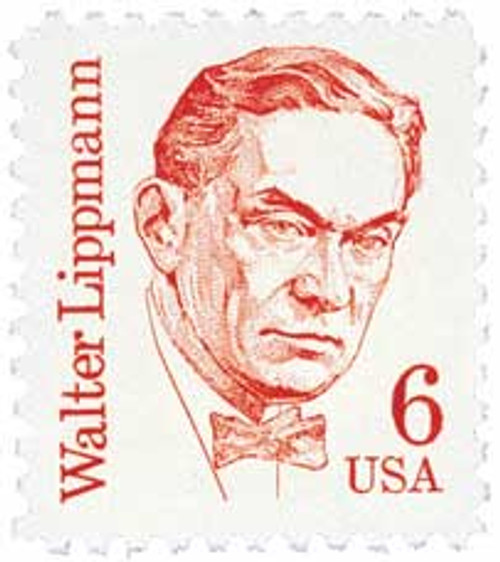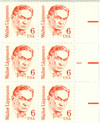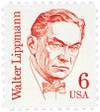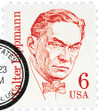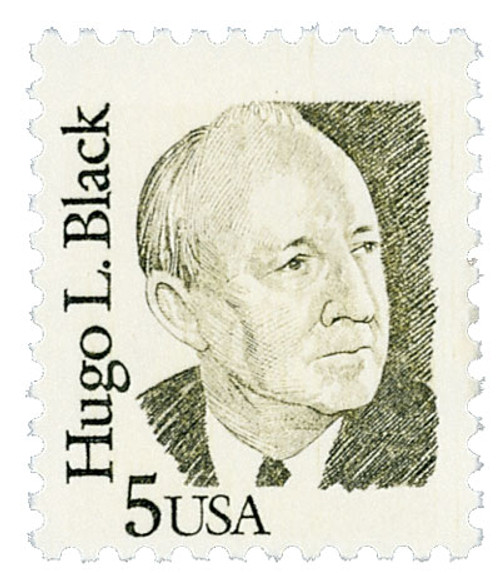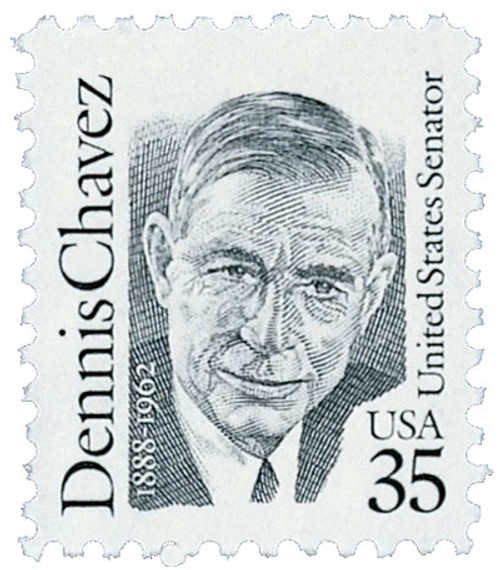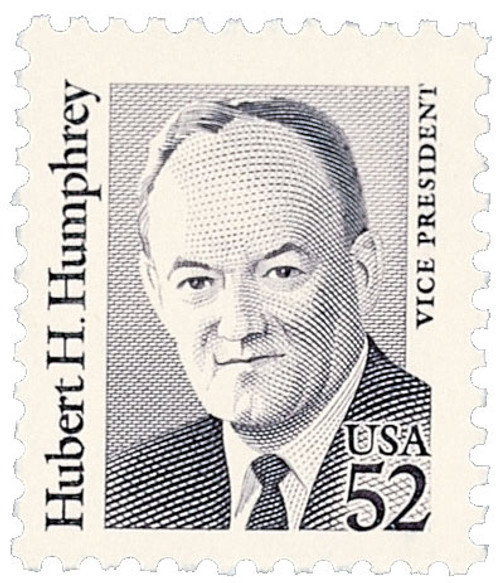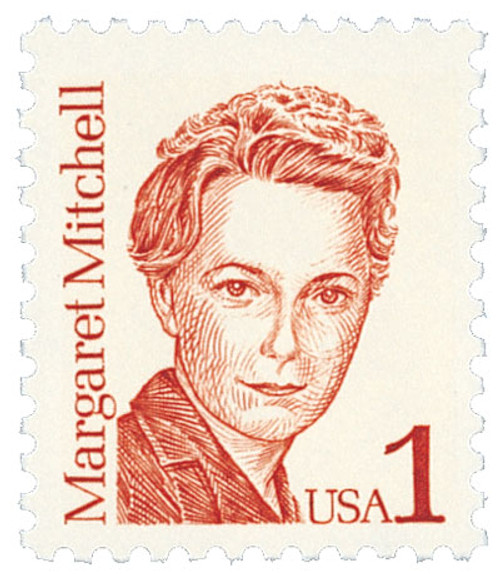
# 1849 - 1985 6c Great Americans: Walter Lippmann
U.S. #1849
1985 6¢ Walter Lippmann
Great Americans
- 26th stamp in the Great Americans Series
- Issued four days after Lippmann’s 96th birthday
- Honors the “Father of Modern Journalism”
Stamp Category: Definitive
Series: Great Americans
Value: 6¢; used predominantly as a “change maker”
First Day of Issue: September 19, 1985
First Day City: Minneapolis, Minnesota
Quantity Issued: 50,700,000
Printed by: Bureau of Engraving & Printing
Printing Method: Engraved
Format: Panes of 100
Perforations: 11
Color: Orange vermilion
Why the stamp was issued: This stamp covered the rate for bulk nonprofit mail presorted to five-digit ZIP codes for 10 or more pieces, or three-digit codes for 50 or more. The more common use for this stamp was as a “change maker.” As Don McDowell of the Stamps Division pointed out, “When a small post office without a meter machine quotes a parcel post rate of $1.86 to a customer, they’d better have the ‘change maker’ stamps on hand to hit it exactly.” These low denominations were also useful in the event of a rate change.
About the stamp design: Dennis Lyall designed this stamp, basing his portrait on a well-known photo taken when Lippmann was middle-aged. This was the seventh stamp to honor a person who spent their entire career in the newspaper business. Of those, only Lippmann and Ernie Pyle spent their entire careers as working newsmen.
First Day City: The First Day ceremony for this stamp was held at the 100th anniversary convention of the National Newspaper Association in Minneapolis, Minnesota.
Unusual fact about this stamp: A small number of imperforate between error stamps have been found.
About the Great Americans Series: The Great Americans Series was created to replace the Americana Series. The new series would be characterized by a standard definitive size, simple design, and monochromatic colors.
This simple design included a portrait, “USA,” the denomination, the person’s name, and in some cases, their occupation or reason for recognition. The first stamp in the new series was issued on December 27, 1980. It honored Sequoyah and fulfilled the new international postcard rate that would go into effect in January 1981.
The Great Americans Series would honor a wider range of people than the previous Prominent Americans and Liberty Series. While those series mainly honored presidents and politicians, the Great Americans Series featured people from many fields and ethnicities. They were individuals who were leaders in education, the military, literature, the arts, and human and civil rights. Plus, while the previous series only honored a few women, the Great Americans featured 15 women. This was also the first definitive series to honor Native Americans, with five stamps.
The Bureau of Engraving and Printing (BEP) produced most of the stamps, but private firms printed some. Several stamps saw multiple printings. The result was many different varieties, with tagging being the key to understanding them. Though there were also differences in perforations, gum, paper, and ink color.
The final stamp in the series was issued on July 17, 1999, honoring Justin S. Morrill. Spanning 20 years, the Great Americans was the longest-running US definitive series. It was also the largest series of face-different stamps, with a total of 63.
Click here for all the individual stamps and click here for the complete series.
History the stamp represents: Journalist Walter Lippmann was born on September 23, 1889, in New York City, New York.
Born into an upper-middle class family, Lippmann attended New York’s Dwight School. He went on to attend Harvard University where he focused on philosophy, German, and French. Lippmann graduated in three years and later joined the New York Socialist Party with Sinclair Lewis.
After briefly serving as secretary to George Lunn, mayor of Schenectady, New York, Lippmann began working as a journalist, media critic, and philosopher. He published several books in the coming years, including A Preface to Politics, Drift and Mastery, The Stakes of Diplomacy, The Political Scene, and Liberty and the News. Lippmann was also one of the founding editors of The New Republic Magazine.
During World War I, Lippmann was made a captain in the Army and joined the intelligence section of the American Expeditionary Forces in France. He was then part of the American Commission to Negotiate Peace. Returning to America, Lippmann became an advisor to President Woodrow Wilson and helped him write his Fourteen Points speech.
Lippmann closely examined the coverage of the war in American newspapers and was bothered by the large number of inaccuracies and biases that many writers included in their reports. He began to criticize these journalists for making generalizations about other people based on preconceived notions. He coined the term “stereotype” largely based on these observations.
Over the years, Lippmann served as an informal advisor for several other presidents. In 1958, he received a special Pulitzer Prize for journalism for “the wisdom, perception and high sense of responsibility with which he has commented for many years on national and international affairs.” He won another Pulitzer for International Reporting four years later for his 1961 interview with Soviet Premier Nikita Krushchev. And in 1964, President Lyndon Johnson awarded him the Presidential Medal of Freedom.
Lippmann died on December 14, 1974, in New York City. As a journalist, Lippmann wrote 26 books and more than 4,000 newspaper columns. He received several other prestigious honors over the years that established him as America’s foremost analyst of social, political, and ethical problems. He’s been called the “most influential journalist” of the 20th century and the Father of Modern Journalism.
U.S. #1849
1985 6¢ Walter Lippmann
Great Americans
- 26th stamp in the Great Americans Series
- Issued four days after Lippmann’s 96th birthday
- Honors the “Father of Modern Journalism”
Stamp Category: Definitive
Series: Great Americans
Value: 6¢; used predominantly as a “change maker”
First Day of Issue: September 19, 1985
First Day City: Minneapolis, Minnesota
Quantity Issued: 50,700,000
Printed by: Bureau of Engraving & Printing
Printing Method: Engraved
Format: Panes of 100
Perforations: 11
Color: Orange vermilion
Why the stamp was issued: This stamp covered the rate for bulk nonprofit mail presorted to five-digit ZIP codes for 10 or more pieces, or three-digit codes for 50 or more. The more common use for this stamp was as a “change maker.” As Don McDowell of the Stamps Division pointed out, “When a small post office without a meter machine quotes a parcel post rate of $1.86 to a customer, they’d better have the ‘change maker’ stamps on hand to hit it exactly.” These low denominations were also useful in the event of a rate change.
About the stamp design: Dennis Lyall designed this stamp, basing his portrait on a well-known photo taken when Lippmann was middle-aged. This was the seventh stamp to honor a person who spent their entire career in the newspaper business. Of those, only Lippmann and Ernie Pyle spent their entire careers as working newsmen.
First Day City: The First Day ceremony for this stamp was held at the 100th anniversary convention of the National Newspaper Association in Minneapolis, Minnesota.
Unusual fact about this stamp: A small number of imperforate between error stamps have been found.
About the Great Americans Series: The Great Americans Series was created to replace the Americana Series. The new series would be characterized by a standard definitive size, simple design, and monochromatic colors.
This simple design included a portrait, “USA,” the denomination, the person’s name, and in some cases, their occupation or reason for recognition. The first stamp in the new series was issued on December 27, 1980. It honored Sequoyah and fulfilled the new international postcard rate that would go into effect in January 1981.
The Great Americans Series would honor a wider range of people than the previous Prominent Americans and Liberty Series. While those series mainly honored presidents and politicians, the Great Americans Series featured people from many fields and ethnicities. They were individuals who were leaders in education, the military, literature, the arts, and human and civil rights. Plus, while the previous series only honored a few women, the Great Americans featured 15 women. This was also the first definitive series to honor Native Americans, with five stamps.
The Bureau of Engraving and Printing (BEP) produced most of the stamps, but private firms printed some. Several stamps saw multiple printings. The result was many different varieties, with tagging being the key to understanding them. Though there were also differences in perforations, gum, paper, and ink color.
The final stamp in the series was issued on July 17, 1999, honoring Justin S. Morrill. Spanning 20 years, the Great Americans was the longest-running US definitive series. It was also the largest series of face-different stamps, with a total of 63.
Click here for all the individual stamps and click here for the complete series.
History the stamp represents: Journalist Walter Lippmann was born on September 23, 1889, in New York City, New York.
Born into an upper-middle class family, Lippmann attended New York’s Dwight School. He went on to attend Harvard University where he focused on philosophy, German, and French. Lippmann graduated in three years and later joined the New York Socialist Party with Sinclair Lewis.
After briefly serving as secretary to George Lunn, mayor of Schenectady, New York, Lippmann began working as a journalist, media critic, and philosopher. He published several books in the coming years, including A Preface to Politics, Drift and Mastery, The Stakes of Diplomacy, The Political Scene, and Liberty and the News. Lippmann was also one of the founding editors of The New Republic Magazine.
During World War I, Lippmann was made a captain in the Army and joined the intelligence section of the American Expeditionary Forces in France. He was then part of the American Commission to Negotiate Peace. Returning to America, Lippmann became an advisor to President Woodrow Wilson and helped him write his Fourteen Points speech.
Lippmann closely examined the coverage of the war in American newspapers and was bothered by the large number of inaccuracies and biases that many writers included in their reports. He began to criticize these journalists for making generalizations about other people based on preconceived notions. He coined the term “stereotype” largely based on these observations.
Over the years, Lippmann served as an informal advisor for several other presidents. In 1958, he received a special Pulitzer Prize for journalism for “the wisdom, perception and high sense of responsibility with which he has commented for many years on national and international affairs.” He won another Pulitzer for International Reporting four years later for his 1961 interview with Soviet Premier Nikita Krushchev. And in 1964, President Lyndon Johnson awarded him the Presidential Medal of Freedom.
Lippmann died on December 14, 1974, in New York City. As a journalist, Lippmann wrote 26 books and more than 4,000 newspaper columns. He received several other prestigious honors over the years that established him as America’s foremost analyst of social, political, and ethical problems. He’s been called the “most influential journalist” of the 20th century and the Father of Modern Journalism.

